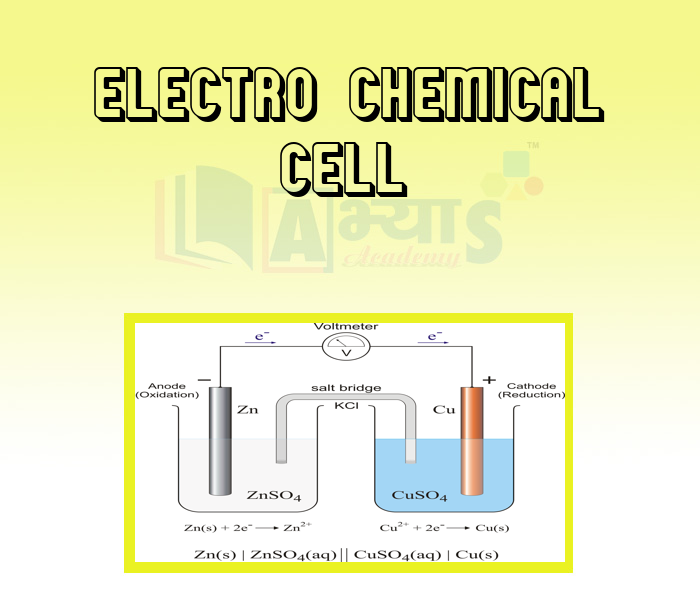Electro Chemical Cell












Electro- Chemical Cell
An electrochemical cell is a device which converts chemical energy into electrical energy. This electrical energy maintains the flow of charge or electrons in a circuit. We can reverse the order that is we provide electric current so that the chemical reactions takes place.So we can say that It is capable of converting chemical energy into electrical energy, or vice versa.
The cells capable of generating an electric current from the chemical reactions occurring in them are called Galvanic cell or Voltaic Cell The cells which cause chemical reactions to occur in them when an electric current is passed through them are called electrolytic cells.The most common example is a dry cell which converts chemical energy into electrical energy. In the case of a rechargable cell we connect it to the mains via a charger so we provide electrical energy to it and it is converted into chemical energy.
It usually consists of two electrodes of different materials and an electrolyte. The electrode at higher potential is called anode and the one at lower potential is cathode.
A common example of an electrochemical cell is a standard 1.5-volt cell which is used to power many electrical appliances such as TV remotes and clocks.

The charge on an electron is 1.6 x 10-19 C, which is negative.
The cells which cause chemical reactions to occur in them when an electric current is passed through them are called ____________________. | |||
| Right Option : A | |||
| View Explanation | |||
Which of the following are correct : (a) The cells capable of generating an electric current from the chemical reactions occurring in them are called Galvanic cell. (b)The cells capable of generating an electric current from the chemical reactions occurring in them are called Voltaic Cell. (c) The cells which cause chemical reactions to occur in them when an electric current is passed through them are called electrolytic cells. | |||
| Right Option : C | |||
| View Explanation | |||
Identify the correct statement /s related to polarization in voltaic cell. (A) When current passes through the voltaic cell, zinc plate starts dissolving in the acid and produces hydrogen bubbles. (B) These hydrogen bubbles accumulate on the coper plate and develop resistance to the flow of current. | |||
| Right Option : C | |||
| View Explanation | |||
Students / Parents Reviews [10]
My experience was very good with Abhyas academy. I am studying here from 6th class and I am satisfied by its results in my life. I improved a lot here ahead of school syllabus.

Ayan Ghosh
8thBeing a parent, I saw my daughter improvement in her studies by seeing a good result in all day to day compititive exam TMO, NSO, IEO etc and as well as studies. I have got a fruitful result from my daughter.

Prisha Gupta
8thA marvelous experience with Abhyas. I am glad to share that my ward has achieved more than enough at the Ambala ABHYAS centre. Years have passed on and more and more he has gained. May the centre flourish and develop day by day by the grace of God.

Archit Segal
7thOne of the best institutes to develope a child interest in studies.Provides SST and English knowledge also unlike other institutes. Teachers are co operative and friendly online tests andPPT develope practical knowledge also.

Aman Kumar Shrivastava
10thAbout Abhyas metholodology the teachers are very nice and hardworking toward students.The Centre Head Mrs Anu Sethi is also a brilliant teacher.Abhyas has taught me how to overcome problems and has always taken my doubts and suppoeted me.

Shreya Shrivastava
8thIt was good as the experience because as we had come here we had been improved in a such envirnment created here.Extra is taught which is beneficial for future.

Eshan Arora
8thIt has a great methodology. Students here can get analysis to their test quickly.We can learn easily through PPTs and the testing methods are good. We know that where we have to practice

Barkha Arora
10thMy experience with Abhyas is very good. I have learnt many things here like vedic maths and reasoning also. Teachers here first take our doubts and then there are assignments to verify our weak points.

Shivam Rana
7thIt was a good experience with Abhyas Academy. I even faced problems in starting but slowly and steadily overcomed. Especially reasoning classes helped me a lot.

Cheshta
10thMy experience with Abhyas academy is very good. I did not think that my every subject coming here will be so strong. The main thing is that the online tests had made me learn here more things.
